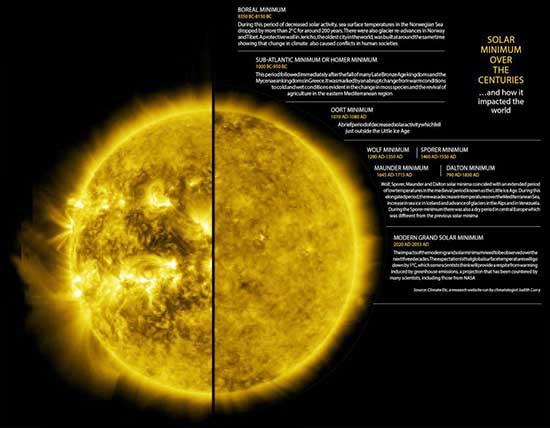News
Cold comfort: The sun is cooling; doesn’t mean there will be no global warming

A new 11-year-cycle of the Sun has begun. Scientists believe the Sun was at its weakest in 2019 in the last 100 years or so — known as the solar minimum — and 2020 marks the beginning of the 25th cycle. But the odd thing is that solar activity, measured by the number of Sun spots at any given time, is pretty low even in 2020.
Sun spots are areas of strong magnetic forces on the surface of the Sun — sometimes as large as planets — that appear as darker spots because they are cooler.
The Sun had no Sun spots for around 71 per cent in 2020 through September 21, 2020, compared to 77 per cent in 2019, according to the United States National Oceanic and Atmospheric Administration’s (NOAA) Space Environment Centre. In May this year, it was as high as 78 per cent, sparking fears of a Little Ice Age.
Scientists say the Sun may be going through a long period of decreased activity known as the Modern Grand Solar Minimum from 2020 to 2053. The last time such an event occurred was during the Maunder Minimum — from 1645 AD to 1710 AD, which was part of what is now known as the Little Ice Age — when Earth went through a series of elongated cold periods during the medieval centuries.
The alarm went off when a study predicted that the surface temperatures on Earth will go down noticeably during the Modern Grand Solar Minimum due to a 70 per cent reduction in solar magnetic activity.
The research paper, by Valentina Zarkhova of Northumbria University, the UK, was published in Temperature on August 4, 2020. To arrive at her conclusion, Zarkhova studied the complex magnetic activity in the interior of the Sun and how this impacts its total energy output measured as solar irradiance.
Variations in solar irradiance lead to heating of the upper layer of the Earth’s atmosphere and influences the transport of solar energy towards the planet’s surface.
Zarkhova studied the magnetic activity through the solar background magnetic field which occurs in the form of two magnetic waves inside the Sun.
When Zarkhova combined these two waves for solar cycles 21-26, she found that the Sun’s magnitude is going down in cycles 24-25 and becoming almost zero in cycle 26. She also found multiple grand solar minima events, including the current event from 2020-2053.
During the Maunder Minimum in the middle ages, the solar irradiance went down by 0.22 per cent or 3 watt per square metre (W/sqm) in 1710 AD when the period ended.
This brought down the temperatures in the Northern Hemisphere, especially in Europe, by 1-1.5 degree Celsius and led to frozen rivers, long cold winters and cold summers. This happened because of the complex impacts of decreased solar activity on the abundance of ozone in the Earth’s atmosphere and on climatic cycles such as the North Atlantic Oscillation (NAO).
The NAO, the balance between a permanent low-pressure system near Greenland and a permanent high-pressure system to its south, was in a negative phase during the Maunder Minimum. This plunged Europe into colder-than usual temperatures. – Down to Earth
News
INS Sahyadri arrives at Port of Colombo

The Indian Naval Ship (INS) Sahyadri arrived at the Port of Colombo on a formal visit on Friday [04 Apr 25]. The visiting ship was welcomed by the Sri Lanka Navy in compliance with naval traditions.
INS Sahyadri is a 143m long Frigate manned by a crew of 320 and the ship is commanded by Captain Rajat Kumar.
During their visit to the crew of INS Sahyadri will participate in events hosted by the Sri Lanka Navy, aimed to strengthen bilateral ties. They will also visit several tourist hotspots across the country.
Concluding the visit, INS Sahyadri is scheduled to set sail from Colombo on 07 Apr
News
JMSDF BUNGO and ETAJIMA depart island

Japan Maritime Self-Defence Force (JMSDF) BUNGO and ETAJIMA which arrived in Sri Lanka on a goodwill visit on 01 Apr 25, departed the island on Friday [04 Apr].
The Sri Lanka Navy bade customary farewell to the departing ships at the Port of Colombo, following naval traditions. Upon leaving, the duo of ships engaged in a successful Passage Exercise (PASSEX) with SLNS Vijayabahu. The PASSEX involved training exercises in communication and tactical maneuvering, concluding with the traditional cheer ship salute.
During their stay in Colombo, crew members of the JMSDF ships took part in several programmes organized by the Sri Lanka Navy, aimed at enhancing mutual cooperation. In addition, they also explored some tourist attractions in Colombo. Further, personnel of Sri Lanka Navy had the opportunity to visit JMSDF BUNGO and ETAJIMA, gaining insights into their operational capabilities.
The Commanding Officers of JMSDF BUNGO and ETAJIMA, Commander TANAKA Koji and Commander ODA Takayuki called on Commander Western Naval Area, and Director General Operations, on 01 Apr.
Latest News
Ceremonial reception for Indian PM Narendra Modi commences

The official welcoming ceremony for the Prime Minister of India, Shri Narendra Modi, who arrived in Sri Lanka on Friday (April 4) night for a three-day state visit, is currently underway at Independence Square in Colombo.
-

 Business1 day ago
Business1 day agoStrengthening SDG integration into provincial planning and development process
-

 News5 days ago
News5 days agoBid to include genocide allegation against Sri Lanka in Canada’s school curriculum thwarted
-

 Sports6 days ago
Sports6 days agoSri Lanka’s eternal search for the elusive all-rounder
-

 Sports2 days ago
Sports2 days agoTo play or not to play is Richmond’s decision
-

 News6 days ago
News6 days agoComBank crowned Global Finance Best SME Bank in Sri Lanka for 3rd successive year
-

 Features6 days ago
Features6 days agoSanctions by The Unpunished
-

 Features6 days ago
Features6 days agoMore parliamentary giants I was privileged to know
-

 Business8 hours ago
Business8 hours agoNew SL Sovereign Bonds win foreign investor confidence










